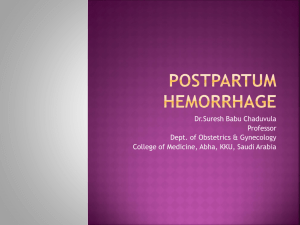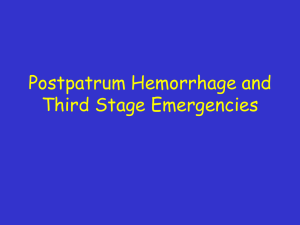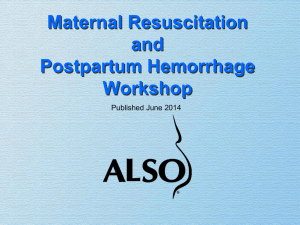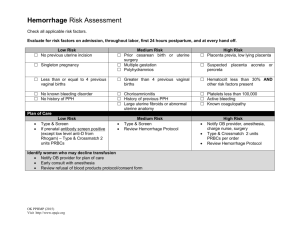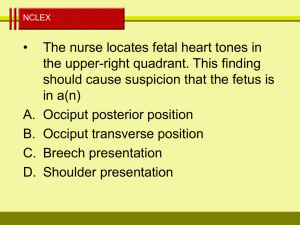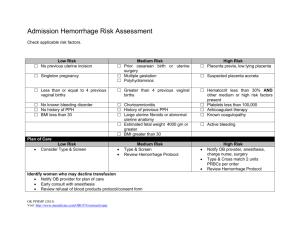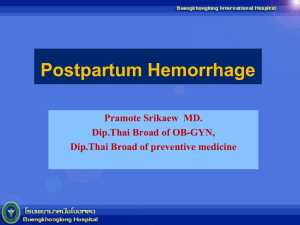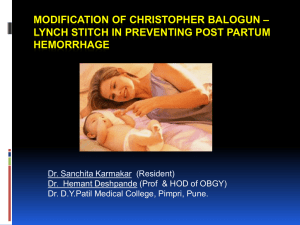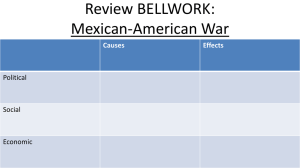Mind Map of Postpartum Hemorrhage
advertisement
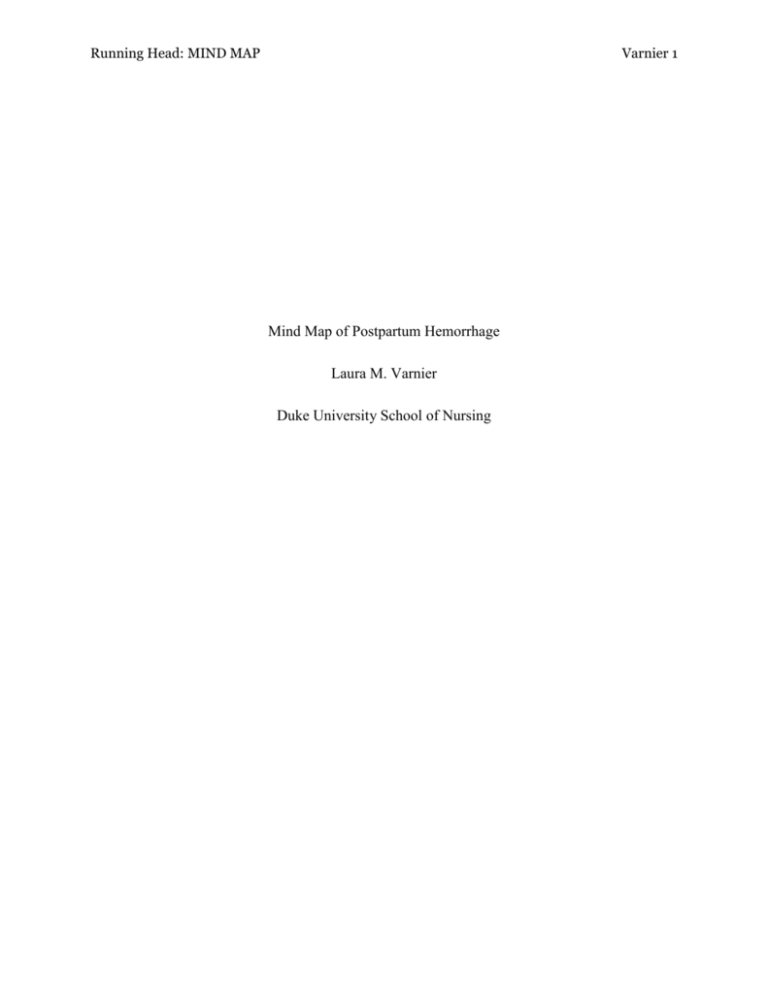
Running Head: MIND MAP Varnier 1 Mind Map of Postpartum Hemorrhage Laura M. Varnier Duke University School of Nursing Mind Map Varnier 2 Introduction and Lesson Learned In the following Mind Map presentation, I have outlined and prioritized key nursing assessments, plans, diagnoses, and interventions, based upon information grounded in evidence, to support a postpartum patient experiencing hemorrhage. I drew from the unit policy of Wake Med Hospital, standard of care from California Maternal Quality Care Collaboration Hemorrhage Taskforce and evidence based research to illustrate key implementation steps to take, as a nurse, based on criteria presented in the case study. Furthermore, the outline of my thoughts walks the reader through the important clinical nursing assessments and diagnoses that led to my prioritized interventions, while my mind map displays a visual portrayal of these same features. By means of this project, I was able to learn new ways that my mind was able to connect key features of the nursing process and allow application of this knowledge in a case study example. Though I did not enjoy the thought of this project since it was presented in the first semester of the ABSN program, I am now able to see how applicable it can be to dividing knowledge, arranging that knowledge and uniting links among key concepts to allow for prioritization of key nursing actions. I felt that the outline provided me with the opportunity to list out all key nursing steps that I would implement and the mind map allowed for a visual representation of my thought processes. This project also highlighted areas that I needed to strengthen within myself, such as my ability to look beyond minute details and see the larger picture. Often times I find myself caught in miniscule details of patient care, when I need to step back and take a more holistic look at the whole patient presentation (for example, not just looking at blood pressure in isolation, but connecting that to other, more serious consequences). I appreciated this project in that it forces students to look at nursing in a different way and step outside of the “concept map” comfort zone that we have come accustomed to. Mind Map Standard of Care from California Maternal Quality Care Collaboration Attached Unit Policy from Wake Medicine Hospital in Raleigh Attached Nursing Evidence Based Research Article Attached Varnier 3 Mind Map Varnier 4 Outline 1) Etiology of case study patient’s postpartum hemorrhage. Early causes of PPH leading to uterine atony include macrosomia (greater than 4,000 grams), polyhydramnios, operative vaginal delivery with use of forceps or vacuum extractor, augmented or induced labor, ineffective uterine contractions during labor resulting in a prolonged first or second stage of labor, precipitous labor, lacerations, hematomas and or birth or the use of general anesthesia (Chapman & Durham, 2010). Our patient displays several early risk factors for PPH: 1. Macrosomic baby- 9lbs 10 oz- approximately 4366 g. i) Risk factors for PPH: “Neonatoal macrosomia: Birth weight greater than 4000 grams” (Chapman & Durham, 2010). 2. Small midline episiotomy. i) “Lacerations are the second most common cause of early PPH” (Chapman & Durham, 2010). 3. Multiple pregnancies- G5P4004 i) Conditions that increase the risk of postpartum hemorrhage includes having many previous births--greater than 4 (UPMC, 2008). 4. Current labor was the longest among previous labor (15 hours) and this contained the largest infant to date. i) Risk factors for PPH: “Ineffective uterine contractions during labor: Prolonged first or second stage of labor” (Chapman & Durham, 2010). Longer labors suggest that uterine muscle endured more stress for a longer amount of time and uterine atony may occur due to uterine exhaustion (Chapman & Durham, 2010). 5. Pitocin use during last part of labor as she “failed to contract adequately”. Mind Map Varnier 5 i) Risk factors for PPH: “Augmented or induced labor” (Chapman & Durham, 2010). Additionally, according to Burke, Pitocin used as an induction strategy early in pregnancy can lead to higher risk for postpartum hemorrhage because the body is not able to clamp down on blood vessels appropriately to ensure that bleeding is controlled (2010). 6. EBL for vaginal delivery was 400 cc. i) “Early PPH is defined as a blood loss of greater than 500 ML within the first 24 hours, but in clinical practice it is diagnosed when the health care provider determines that the blood loss is greater than normal” (Chapman & Durham, 2010). ii) “Visual estimation of blood loss volume is inaccurate and can underestimate postpartum blood loss by 33%-50% when compared to the gold standard for quantifying blood loss, which is photospectrometry or colorimetric measurement of alkaline heamtin in blood. Visual estimation of blood loss may be complicated by the presence of large volumes of amniotic fluid, stool or sponges” (CMQCC, 2010). 7. Excess fluid intake without voiding can lead to an overdistended bladder and an inability of the uterus to contract appropriately. i) Patient has taken in 1100 cc orally since birth and has had 2000 LR over the course of the last 12 hours, while compensating once during birth (void amount not recorded) and a scant amount of approximately 100 cc after birth. ii) “Assess for a displaced uterus. An overdistended bladder can displace the uterus and cause it to relax” (Chapman & Durham, 2010). Late Signs of PPH include hematomas, subinvolution and retained placental tissue (Chapman & Durham, 2010). Mind Map Varnier 6 2) Patient presentation at 1930. Patient states that she is “feeling lightheaded” and looks pale. She is currently eating a snack. i) Pale color and clammy skin may be an early assessment finding of uterine atony, the leading cause of early PPH (Chapman & Durham, 2010). 3) Assessment data at 1930. 1. Patient looks pale. i) Paleness can be indicative of blood loss and an early sign of uterine atony, the leading cause of early PPH (Chapman & Durham, 2010). 2. Current BP 78/40 mmHg has fallen significantly from blood pressure at 1800 of 120-130/8084 mmHg. i) Hypotension can be an early assessment finding of uterine atony (Chapman & Durham, 2010). 3. Current pulse of 124 beats per minute has increased significantly since 1800 to 88 bpm. i) Tachycardia can be an early assessment finding of uterine atony (Chapman & Durham, 2010). 4. Patient states that she is having “severe cramps”. i) “Uterine contractions constrict the open vessels at the placental site and assist in decreasing the amount of blood loss. When the uterus is relaxed the vessels are less constricted and the woman experiences an increase of blood loss” (Chapman & Durham, 2010). Our patient’s uterine cramping is a good sign her body is attempting to clamp off bleeding blood vessels, though this mechanism may not be compensating adequately. Mind Map Varnier 7 5. Uterus has involuted to 4/U, an increase of two fingerbreadths from her last assessment at 1800 (where it was located at 2/U). i) “Subinvolution of the uterus occurs when the uterus does not decrease in size and does not descend into the pelvis. Risk factors include fibroids, endometritis, and retained placental tissue” (Chapman & Durham, 2010). The woman may need to be examined for retained placental tissue, by dilation and curettage or a sterilized manual sweep by a physician/CNM, which may also explain her lochia being heavy and containing clots (Chapman & Durham, 2010). 6. Uterus is deviated to the right. i) “Assess for a displaced uterus. An overdistended bladder can displace the uterus and cause it to relax” (Chapman & Durham, 2010). A uterus displaced to the right is indicative of an overdistended bladder. 7. Uterus is boggy and does not firm up to massage. i) A uterus that is boggy and does not firm up to massage is indicative of uterine atony leading to postpartum hemorrhage without further intervention (Chapman & Durham, 2010). 8. Lochia is characterized by “silver dollar” sized clots. i) Blood clots found in assessment finding can be indicative of uterine atony: “Express clots: clots can interfere with uterine contraction” (Chapman & Durham, 2010). Large clots need to be weighed and assessed to determine EBL. 9. EBL of 750 cc of bright red blood. i) When adding the amount of blood loss during delivery (400cc), the lochia assessment of moderate to heavy at 1800, has increased at current assessment to 750cc, with total blood Mind Map Varnier 8 loss equivalent to 1150 cc; this categorizes our patient into the greater than 500 cc blood loss for vaginal delivery and emergency PPH protocol needs to be activated. 10. Allergies- Both the chart and assessment handoff performed by the previous nurse did not assess allergies. This would be a good question for the incoming nurse to ask the patient. 11. Assessment of lab results: lab results, according to standing orders, are not required until the morning after delivery. The assessment of the patient Hct/Hgb lab results after delivery is a critical assessment in relation to the patient’s current status. i) Normal Hematocrit value- 35-50%; Normal Hemoglobin value 12-17.5. 12. Other assessment item of note: patient does have current heplocked IV access available, if necessary; patient needs to be placed on high falls precaution related to drop in BP and active bleeding which can lead to orthostatic hypotension. 4) Collaborative problem list: 1. Fluid volume deficit related to hypotension, tachycardia, decreased urinary output, uterine atony, and increased lochia. 2. Altered tissue perfusion related to pale skin and hypovolemia (blood loss). 3. Acute pain related to severe cramping and medication interventions necessary to control bleeding. 4. Delay in mother-infant attachment related to being unable to care for newborn and fatigue acquired during blood loss. 5. Interrupted breastfeeding related to separation from infant for medical treatment. i) “Among women with a significant PPH, 63% fully breastfed their babies from birth, whereas 85% said they had hoped to do so (p < 0.001). Only 52% of mothers who Mind Map Varnier 9 intended to either fully or partially breastfeed were able to give their baby the opportunity to suckle within an hour of the birth. Delays were longer in women with greater estimated blood loss and women with the longest delays in breastfeeding were less likely to initiate full breastfeeding” (Thompson et al., 2010). 6. Anxiety related to blood loss and increase in medical professional attention. 7. Risk for infection related to loss of blood and depressed immunity, especially at episiotomy suture line. 5) Goal of Nursing intervention: 1. To prevent further hemorrhage and re-establish homeostasis; According to Burke, postpartum hemorrhage is defined as vaginal delivery accompanied by blood loss greater than 500mL and caesarean birth by loss greater than 1000 mL blood loss (2010). 6) Plan and Nursing Interventions to prevent postpartum hemorrhage. *Note: Nursing interventions are based upon evidential support for active management of the third stage of labor. According to Burke, “evidence-based literature and the WHO support and recommend the active management of the third stage of labor approach asserting that [in utilizing the active management protocol] blood loss and the risk of PPR are decreased by 68%” (2010). 1. Call for help while activating Wake Med Hospital postpartum hemorrhage protocol (Wake Med Raleigh Process Standards, 2010). Stay with the patient throughout all interventions. Another nurse needs to retrieve all medications and supplies from outside of the patient’s room. Mind Map Varnier 10 (1) According to the California Maternal Quality Care Collaboration protocol on Obstetric Hemorrhage cases, the patient’s high risk status would have previously placed her into the category to be T&C for 2 U of blood (CMQCC, 2009). The woman has entered stage 1 of the Hemorrhage Care guidelines due to her vital changes by 15% and blood loss greater than >500 mL vaginally, continuing to stage 2 with continued bleeding and total blood loss under 1500mL. (2) Ensuring a current Type and Screen is also a priority intervention according to Wake Med Raleigh Process Standards (2010). (3) Ask another nurse to retrieve the Wake Med postpartum emergency kit from the centralized nursing station. 2. Begin full vital sign assessments, including BP, HR, RR, O2 saturation level, every 5 minutes continuously. i) “Monitor vital signs continuously. Look for tachypnea, tachycardia, pallor, cyanosis, and shock” (Wake Med Process Standards, 2010). 3. “Assess amount of blood loss, clots, odor, bright or dark color. Check uterus for atony, fundal height, position and abdominal tenderness” (Wake Med Raleigh Process Standards, 2010). i) “The physician or midwife is notified when the fundus does not respond to fundal massage” (Chapman & Durham, 2010). If the fundus is non-responsive, it is necessary to summon the MD/CNM at this time. 4. Assess patient’s ability to move to bathroom to void (most likely not a possibility) or prepare patient for a Foley catheter, in order to drain the bladder and allow the uterus to contract properly. Mind Map Varnier 11 i) “Assist the woman to the bathroom to void if the uterus is not midline and then re-assess the location and firmness of the fundus and the amount and characteristics of the lochia. Catheterize the woman if she is unable to void and the uterus is displaced by the overdistention of the bladder (Chapman & Durham, 2010). ii) Wake Med Raleigh Process Standards states “empty bladder by foley cath or void” (2010). 5. Open heplocked IV access and, according to doctor’s prescribed orders, begin 20 U IV Pitocin in 1000 cc lactated ringers (40 U IV Pitocin in 1000 mL LR according to Wake Med protocol). i) “Establish IV line with large bore angiocath and bolus fluids as ordered” (Wake Med Raleigh Process Standards, 2010). ii) The IV infusion rate of Pitocin is started at 10-40 mL/min and regulated by the firmness of the fundus (Chapman & Durham, 2010). 6. “Start O2 via face mask, non-rebreather at 10-12 L/min. Assist patient to lateral position if possible. Elevate legs to a 20-30 degree angle to increase venous return (Trendelenburg)” (Wake Medicine Process Standards, 2010). 7. Prepare Methergine 0.2 mg IM injection (permitted due to current BP reading of 78/40 mmHg) to promote cessation of bleeding (utertonic medication). *Stage 2 protocol according to CMQCC, 2009: Continue to call for additional help, while ensuring that the OB is back at the bedside, and proceed in taking the patient to the OR for further implementation measures. 8. Access 2nd IV site with an 18 gauge syringe, appropriate for blood transfusions. According to CMQCC standards, notify blood bank of patient’s OB Hemorrhage situation; if type and Mind Map Varnier 12 screen was not previously conducted or has not returned from laboratory, begin O- blood transfusion of 2 Units of PRBCs (CMQCC, 2009). 9. Continue medication administration, according to MD orders, of Hemabate 250 mcg IM (if patient does not have a history of asthma) or Misoprostol 800-1000 mcg PR (Chapman & Durham, 2010). 10. Assist MD in any additional procedures that follow, including repairing any tears, D&C, intrauterine balloon placement, selective embolization, sterilized uterine sweep, etc. *Continue to stage 3 of CMQCC protocol, 2009: If vitals continue to be unstable, blood loss reaches over 1500 mL, there is suspicion of DIC or >2 units of PRBCs are given, “continue to massive aggressive transfusion protocol and invasive surgical approaches for control of bleeding”, which includes continued assistance requested, placing a central line, repeat labs, hysterectomy, etc. According to the routine provider order prioritization (provided in the case study information): Complete these orders now: 1) Pitocin 20 U in IV (1000 cc LR) for heavy bleeding. 2) Methergine 0.2 mg IM if pressures are normal. *Continue with hemorrhage protocol according to hospital policy. Obtain an order for a STAT Hct/Hbg lab, prior to order the morning after delivery. Once hemorrhage episode has been managed and has ended: Mind Map Varnier 13 3) Manage patient pain with Tylenol (325 mg, 1-2 tabs, PO, PRN, as ordered) or Percocet (1-2 tabs, PO, PRN, as ordered). Further pain reduction medications, such as Morphine, may be needed for D&C and manual sterile uterine sweep; pain management should be discussed with the medical team and tailored to fit the patient’s needs. 4) Provide patient and support system an opportunity to ask questions and review what events occurred; this allows for anxiety to decrease and understanding to develop. 5) Baby to breast every 2-3 hours, around the clock; ensure considerations if the patient is supplied with additional pain medication (aside from Tylenol and Percocet) for this to influence both the mother’s mental state and breast milk. a) “Oxytocin allows for milk ejection and uterine contractions that help to maintain uterine tone” (Burke, 2010). 6) Ice to perineum for first 12 hours, then may initiate sitz bath PRN. 7) May ambulate and shower when stable (with nurse assist on first OOB). 8) Regular diet, advance as tolerated, fluids as tolerated. 9) Move to PP floor. 10) D/C IV when stable. 11) Hct/Hgb morning after delivery (10-11-2011). 12) For breastfeeding issues, may consult lactation consultant. PRN Medications: Tylenol 325 mg. 1-2 tabs PRN for pain. Percocet 1-2 tabs, PO, PRN for pain. Lanolin for nipple tenderness PRN. Mind Map Varnier 14 13) Evaluation of Intervention Actions: a) Fluid status returns to baseline as evidence by mental status, skin color, and vital signs return to stable condition/baseline. b) Patient does not show signs of increased lochia output or clots, patient does not saturate a peripad within an hour’s time. c) Fundus firms to massage and is midline. d) Pt states pain is adequately managed and pain reassessment occurs within one hour of pain medication administration. e) Hct/Hgb are within normal limits. f) Patient able to provide and bond with child and return to normal ADLs and ambulation. g) Patient and support system’s anxiety is decreased and emotional support is provided to supply teaching and allow for questions. h) Monitor for signs and symptoms of infection: ecchymosis, redness, edema, drainage and approximation at episiotomy site. Mind Map Varnier 15 References Burke, C. (2010). Active versus expectant management of the third stage of labor and implementation of a protocol. Journal of Perinatal Neonatal Nursing, 24 (3): 215-228. California Maternal Quality Care Collaboration (2009). Hemorrhage Taskforce. State of California, Deparment of Public Health, Center for Family Health; Maternal, Child and Adolescent Health Division. www.CMQCC.org. California Maternal Quality Care Collaboration (2010). Blood loss: Clinical techniques for ongoing quantitiative measurement. State of California, Department of Public Health, Center for Family Health: Maternal, Child and Adolescent Health Division. www.CMQCC.org. Chapman, L. & Durham, R. (2010). Maternal-Newborn Nursing: The critical components of nursing care. F. A. Davis Company: Philadelphia, PA. Thompson, J. F., Heal, L. J., Roberts, C. L., & Ellwood, D. (2010). Women’s breastfeeding experiences following significant primary postpartum haemorrhage: A multicentre cohort study. International Breast Feeding Journal, 5 (5): 1-12. UPMC. (2008, February 3). Postpartum hemorrhage. Retrieved from http://www.chp.edu/CHP/P02486. Wake Med Raleigh Process Standards (2010). Emergency care of the obstetrical patient. Raleigh, NC: Wake Med Health System.
